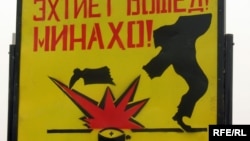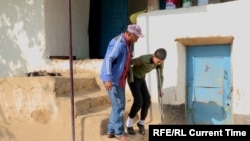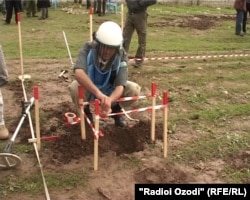There was more good news in Tajik-Uzbek relations on October 6, when the head of the Tajik president's Center for Strategic Research, Hudoyberdy Holiqnazar, announced demining work had started along the border with Uzbekistan.
Bilateral ties have improved dramatically since Shavkat Mirziyoev took over as Uzbekistan's leader in September 2016. But under Uzbekistan's previous president, Islam Karimov, there were many problems between the two countries. Perhaps no problem so clearly demonstrated the level of distrust, and at times animosity, as Uzbekistan's decision to plant land mines along its border with Tajikistan.
Dozens, certainly, possibly hundreds of people living in the border area have been killed or injured by these land mines.
"Work has already started on clearing the land mines, and very soon inhabitants of the border region will forget about the danger of land mines," Holiqnazar said.
Maybe not so soon.
Uzbekistan put the land mines along the border in August or September (or both) 2000. That was the second straight summer that regional officials and the Islamic Movement of Uzbekistan (IMU) itself said IMU militants descended from the mountains of Tajikistan into southern Kyrgyzstan, and the first summer they penetrated into southeastern Uzbekistan. Uzbek troops discovered, as Kyrgyz troops had in the summer of 1999, that tracking small groups of IMU militants in the rugged foothills of the Pamir Mountains was a formidable challenge.
On October 4, 2000, then-Uzbek Defense Minister Kodyr Gulomov announced that "as we do not have the possibility to erect checkpoints everywhere on the border, the most vulnerable parts are being equipped with the necessary technical means." If in that sentence "technical means" can be seen as a reference to land mines, it marked the first time an Uzbek official confirmed that land mines were being planted there.
Tajik authorities already knew. On October 12, Tajik citizen Tursun Makhamov was killed by a land mine while herding sheep in the Tajik-Uzbek border area. According to Tajik authorities, he became the 12th Tajik citizen killed by land mines along the border with Uzbekistan since the start of September. Six other people had been wounded during that time.
On November 10, 2000, Gulomov expressed Uzbek regret over the deaths of Tajik citizens but said land mines were the only way to secure the border.
On February 7, 2001, the then-chairman of Tajikistan's State Border Committee, General Saidanvar Kamolov, reported that two men who had been killed in a land-mine explosion near Uzbekistan brought to 28 the number of Tajik citizens killed in the border area over the course of roughly six months.
There were reports of people killed and wounded in land-mine explosions on the Tajik side of the border every year after that; often they were people gathering wood, usually children, or shepherds.
The then-head of Tajikistan's Mine Action Center, Jonmahmad Rajabov, said at the start of February 2004 that 62 Tajik citizens had been killed by land mines near the Uzbek border and nearly the same number wounded since 2000.
Tajik officials repeatedly complained about the land mines to Uzbekistan, but without any obvious result. In November 2009, Uzbek Ambassador to Tajikistan Shokosim Shoislomov said his country had no intention of removing the land mines or of giving Tajikistan maps of where the land mines were laid. "These mines in mountains do not affect anybody, and there is nothing to do for a normal person in such remote places," Shoislomov said. "Only those who want to cross the border illegally are going there. It is these people against whom mines were planted at certain sections of our border with Tajikistan."
Slow Progress
And so, the situation remained. Fewer citizens of Tajikistan have been killed by land mines along the border with Uzbekistan in recent years simply because residents of the area have learned to fear straying into this region.
Tajikistan has been demining the border on its own. Two deminers have been killed and 20 more wounded over the course of nearly two decades.
Citizens of Uzbekistan have been killed by some of these land mines too, but their number is unknown, since it is never or rarely reported by Uzbek authorities.
Mirziyoev deserves some credit. Uzbek Prime Minister Abdullo Aripov announced a decision to work with Tajikistan to remove land mines along the Tajik border in January 2018 when he was visiting Tajikistan to prepare for Mirziyoev's visit in March, the first official visit by an Uzbek leader to Tajikistan in 18 years.
The press secretary for Tajikistan's Border Department, Muhammadjon Ulughojaev, told RFE/RL's Tajik Service, known locally as Ozodi, that a delegation from Tajikistan that included representatives of the Border Department, Defense Ministry, and the Mine Action Center had traveled on October 7 to Tashkent, where Uzbek officials handed over maps of where the land mines were placed.
Tajikistan's Mine Action Center released information to accompany Holiqnazar's announcement that showed in the past 20 years, 374 citizens of Tajikistan were killed and 485 wounded by land mines, although not all those casualties were from the Uzbek border area. Land mines were planted further inside Tajikistan during the 1992-97 civil war and by border guards in areas along the frontier with Afghanistan.
Under agreements reached during Mirziyoev's visit to Tajikistan in March, the Tajik-Uzbek border area should be cleared of land mines by the end of 2019.









